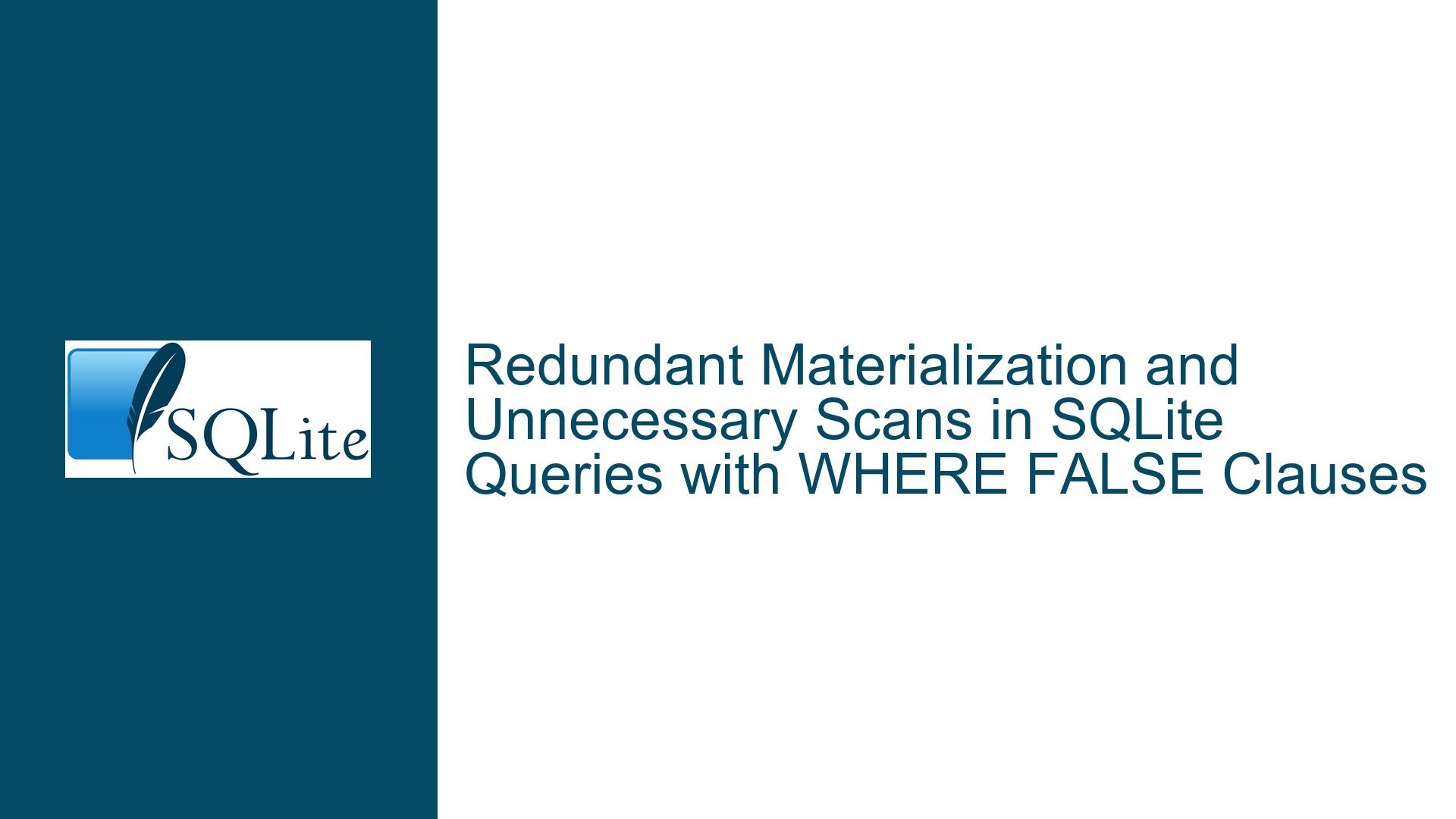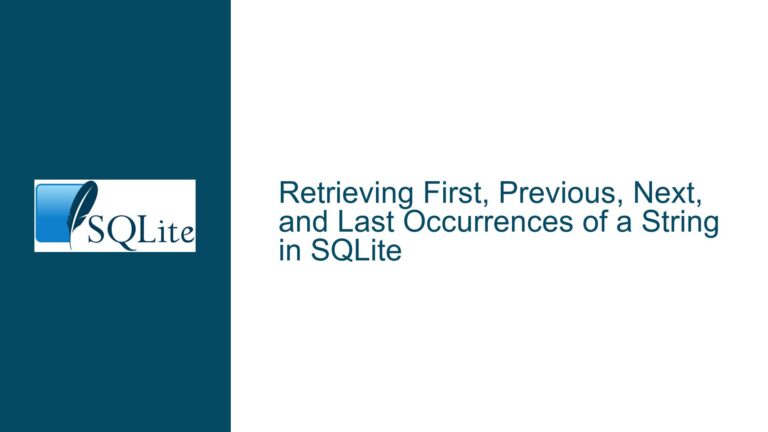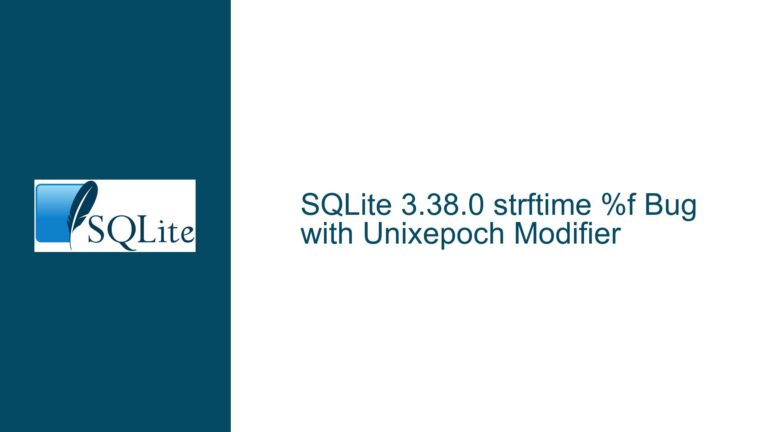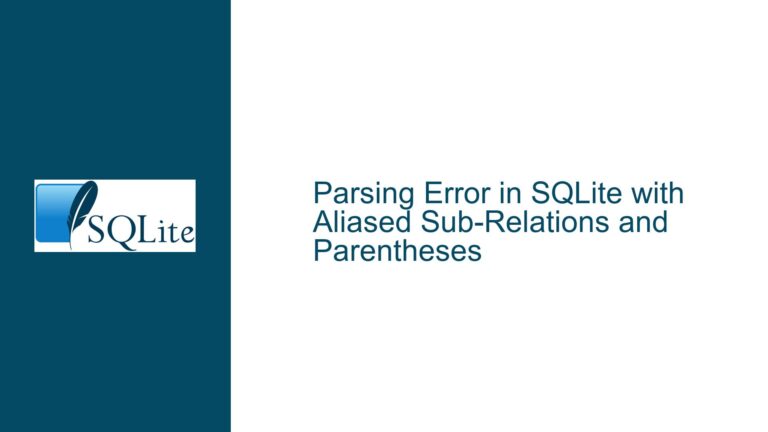Redundant Materialization and Unnecessary Scans in SQLite Queries with WHERE FALSE Clauses
Query Behavior Analysis for Contradictory Filter Conditions
Core Problem: Execution Plan Discrepancies with WHERE FALSE
The central challenge revolves around understanding why SQLite generates query plans that appear to perform unnecessary table scans and view materializations when presented with logically contradictory filter conditions like WHERE FALSE. This manifests in two specific ways:
- Persistent data access operations (SCAN directives) in EXPLAIN QUERY PLAN output despite impossible result sets
- Duplicate MATERIALIZE operations for the same view in query execution plans
The test case demonstrates this through a minimal schema with base tables, derived views, and cross-joined virtual objects. Key components include:
- Base table t0 with single integer column
- View v1 calculating a DISTINCT COUNT aggregation over t0
- View v2 performing a cross join between t0 and v1
- Final query attempting to select distinct values from multiple v1 instances joined through v2 while applying WHERE FALSE
Execution plan output shows:
- Multiple materializations of view v1
- Repeated SCAN operations on both base table and views
- Temp B-Tree usage for distinct value processing
This contrasts with PostgreSQL’s approach where the query planner recognizes the impossible filter early and eliminates all data access operations, demonstrating fundamental differences in database engine architecture.
Optimization Pipeline Limitations and Materialization Requirements
1. Filter Condition Evaluation Timing
SQLite’s query planner operates in multiple phases:
- Syntax Parsing: Builds abstract syntax tree from SQL text
- Semantic Analysis: Resolves object references and validates schema
- Logical Optimization: Applies rule-based transformations
- Code Generation: Produces VDBE bytecode for execution
The WHERE FALSE clause gets processed during the logical optimization phase, but its impact depends on how deeply the optimizer can prune operation trees. Unlike PostgreSQL’s cost-based optimizer that performs constant folding and dead code elimination early, SQLite’s simpler optimizer may retain structurally important elements of the query even when their results are provably empty.
2. View Materialization Mechanics
Each view reference in a FROM clause typically triggers separate materialization when:
- The view contains aggregate functions (COUNT/SUM/etc)
- DISTINCT clauses are present
- Multiple references to the same view exist in complex joins
In the test case, view v1 contains both an aggregate (COUNT(*)) and DISTINCT modifier. When v1 appears multiple times in the query’s FROM clause (both directly and via v2’s definition), SQLite’s current implementation creates separate materializations rather than reusing cached results due to:
- Temporary Table Scope Limitations: Materialized views use ephemeral storage tied to specific cursor positions
- Join Order Dependencies: Later query stages may require different access patterns to the same logical dataset
- Query Flattening Restrictions: Complex view hierarchies prevent view merging optimizations
3. Execution Plan Representation Artifacts
EXPLAIN QUERY PLAN shows high-level operational intent rather than actual runtime behavior. The SCAN directives represent structural dependencies in the query’s data flow graph, not necessarily physical I/O operations. When combined with contradictory filters, these elements remain visible in the plan despite never executing at runtime.
Resolution Strategy: Validation and Optimization Techniques
Phase 1: Validate Actual Execution Behavior
Bytecode Inspection
Run the query with EXPLAIN rather than EXPLAIN QUERY PLAN to see VDBE (Virtual Database Engine) instructions:EXPLAIN SELECT DISTINCT v1.c0 FROM v2, v1 WHERE FALSE;Analyze output for:
- Goto instructions bypassing data access operations
- Halt codes appearing before table access opcodes
- NullRow operations replacing actual data fetches
Example diagnostic markers:
addr opcode p1 p2 p3 0 Init 0 15 0 1 Goto 0 14 0 ... [skipped] 14 Halt 0 0 0Runtime Profiling
Use SQLITE_STMT virtual table or sqlite3_profile() callback to measure:- Actual page read counts
- Heap memory allocations
- Temporary storage usage
Compare metrics between queries with WHERE TRUE and WHERE FALSE to detect suppression of physical operations.
Phase 2: Query Structure Transformation
View Definition Simplification
Rebuild views to eliminate unnecessary complexity that triggers multiple materializations:Original:
CREATE VIEW v2(c0) AS SELECT t0.c0 FROM t0, v1;Optimized:
CREATE VIEW v2(c0) AS SELECT t0.c0 FROM t0 CROSS JOIN (SELECT DISTINCT COUNT(*) FROM t0);This moves v1’s logic inline, allowing the optimizer to consider context during materialization decisions.
Common Table Expression (CTE) Materialization
Use WITH clauses to control view instantiation:WITH v1_materialized AS MATERIALIZED ( SELECT DISTINCT COUNT(*) AS c0 FROM t0 ) SELECT DISTINCT v1.c0 FROM v2, v1_materialized v1 WHERE FALSE;The MATERIALIZED keyword forces single instantiation while making reuse explicit.
Join Order Enforcement
Add manual CROSS JOIN syntax and LEFT JOINs with impossible ON clauses to guide the planner:SELECT DISTINCT v1.c0 FROM v2 LEFT JOIN v1 ON 1=0 WHERE FALSE;
Phase 3: Engine-Specific Optimizations
Query Planner Control
Use PRAGMA directives to enable advanced optimizations:PRAGMA optimize; PRAGMA automatic_index = OFF; PRAGMA query_only = ON;Combine with SQLITE_STAT tables to provide artificial statistics that help the planner recognize empty result potential.
Subquery Flattening Prevention
Add opaque expressions to view definitions to block merge optimizations:CREATE VIEW v1(c0) AS SELECT DISTINCT COUNT(*) + ABS(RANDOM()%0) FROM t0;The RANDOM() function prevents view merging while maintaining equivalent results.
Materialization Hints
Use proprietary syntax extensions via SQLITE_ENABLE_UPDATE_DELETE_LIMIT to control temp table usage:SELECT DISTINCT v1.c0 FROM v2 NOT MATERIALIZED, v1 NOT MATERIALIZED WHERE FALSE;
Phase 4: Schema Redesign Patterns
Base Table Partitioning
Replace views with partial indexes and covered queries:CREATE TABLE t0 (c0 INT); CREATE INDEX t0_cover ON t0(c0, (COUNT(*) OVER ())); SELECT DISTINCT cnt FROM t0_cover WHERE FALSE;Persistent Materializations
Convert frequently used views into shadow tables maintained via triggers:CREATE TABLE v1_shadow (c0 INT); CREATE TRIGGER t0_v1_update AFTER INSERT ON t0 BEGIN DELETE FROM v1_shadow; INSERT INTO v1_shadow SELECT DISTINCT COUNT(*) FROM t0; END; SELECT DISTINCT v1.c0 FROM v2, v1_shadow v1 WHERE FALSE;Expression Indexing
Precompute aggregations in generated columns:CREATE TABLE t0 ( c0 INT, cnt INT GENERATED ALWAYS AS (SELECT COUNT(*) FROM t0) VIRTUAL ); CREATE VIEW v2(c0) AS SELECT c0 FROM t0, (SELECT DISTINCT cnt FROM t0);
Phase 5: Engine Comparison and Workarounds
PostgreSQL-Style Optimization Simulation
Implement Lua/Javascript extensions to perform query rewriting:SELECT DISTINCT v1.c0 FROM v2, v1 WHERE CASE WHEN FALSE THEN 1 ELSE 0 END;Combine with user-defined functions that abort execution early.
Query Guard Clauses
Add volatile function wrappers to force early filter evaluation:SELECT DISTINCT v1.c0 FROM v2, v1 WHERE sqlite_early_abort(FALSE); -- Register C function: void sqlite3_early_abort(sqlite3_context* ctx, int argc, sqlite3_value** argv) { if (!sqlite3_value_boolean(argv[0])) { sqlite3_result_error_code(ctx, SQLITE_ABORT); } }Plan Stability Techniques
Use SQLite’s newer strict tables and generated columns to constrain planner choices:CREATE TABLE t0 (c0 INT STRICT); CREATE VIEW v1(c0) AS SELECT DISTINCT COUNT(*) FROM t0; ANALYZE;Strict mode reduces implicit coercions that complicate plan optimization.
Final Recommendations
For production systems encountering similar issues:
- Trust Bytecode Over Plans: Use EXPLAIN to validate actual execution flow
- Materialize Judiciously: Convert problematic views to CTEs or temp tables
- Guide the Planner: Use INDEXED BY and JOIN syntax to constrain choices
- Monitor Evolution: Track SQLite version changes in query optimization
- Accept Engine Limits: Recognize SQLite’s pragmatic tradeoffs between complexity and reliability
These strategies balance immediate problem resolution with long-term maintainability, acknowledging SQLite’s unique architecture while leveraging its extensibility to overcome optimization edge cases.






